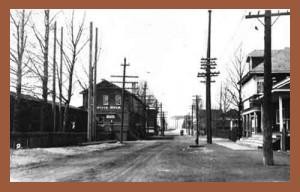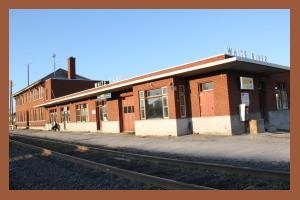Historic is truly the appropriate adjective for White River, a town whose heritage tells a unique story of a distinct kind of community in a specific era of Canadian history.
An era of Canadian history?
Yes, and rather a lengthy one as far as historical eras go.
From the time that the railway was completed through Northern Ontario in 1885 until the Trans-Canada Highway opened in 1961, 76 years passed. The railway era was the time in Canada’s past during which rail was the most important means for moving people and things in and out of town. This era lasted longer in places like White River, because of its isolation from other means of transport and continued dependence on the tracks.
White River was distinctly a railway town in the railway era of our country’s history. However, White River was not just any sort of railway town; this community distinguished itself from other railway towns by being a Northern Ontario railway town. The Canadian Pacific Railway had railway towns in the Rocky Mountains, the Canadian Prairies, and the Canadian Shield, all of which had different purposes and different personalities. Weather, landscape, and natural resources were the three greatest forces determining the nature of a railway town. White River is, of course, famous for its hearty climate and ought to be as well known for its beautiful landscape and abundant resources. However, there was a fourth factor of great importance to the unique story of White River: location.
From the beginning, building rail towns in the Canadian Shield, with its harsh climate and difficult topography, was a necessary evil for the CPR. Northern Ontario was primarily a connector on the all Canadian rail route from the industrial heartland of Central Canada to the colonial farmland of the Prairie provinces and the resource hinterland of British Columbia. In crossing this vast region, a stopover point had to be located somewhere. William Van Horne, chief builder for Canadian Pacific, picked the perfect divisional point for the area: a tiny settlement that he referred to as Snowbank. Snowbank might have been a work camp for the CPR in 1885; but in any case, by 1886 White River’s precursor had completely disappeared, having been replaced by a modern rail town.
The perfect divisional and stopover point needed a few obvious things such as a deluxe station house and fine hotels. Perhaps less obviously such a town needed an ice house and a steady supply of ice (cut from nearby Picnic Lake). Connecting the farmlands of the West with the urban centres to the South necessitated a stockyard for feeding and watering livestock that travelled regularly through White River.
Travelling-through was an activity of historical significance to White River in its early days. Consider the politicians and dignitaries who had to stop in White River on their way west on the all-Canada route.
Another group who were constantly traveling through in the rail era were soldiers. In 1885 when John A. MacDonald decided to put down the Riel Rebellion in Saskatchewan, eastern troops traveled west through White River. In 1914 when the Great War broke out in Europe, western troops (with their horses) traveled east through White River on their way to Canada’s Atlantic ports.
The railroad was never just an industry unto itself. When the railway opened Northern Ontario to new industries and dramatically changed traditional industries (such as the fur trade), White River supplied regional foresters, miners, and fur traders with dry goods, mail, and merchandise, all brought into the area by train.
Railway Speeder restored by Tom Bagdon in 1999.




